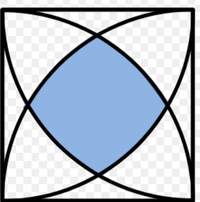The Blue One!
A B C D is a square with side length of 4 cm . Four quarter-circles are drawn with vertices of the square as their centres and radius 4 cm as shown in the figure. What is the area of the blue region (to 3 decimal places)?

Bonus: Use geometry.
The answer is 5.042.
This section requires Javascript.
You are seeing this because something didn't load right. We suggest you, (a) try
refreshing the page, (b) enabling javascript if it is disabled on your browser and,
finally, (c)
loading the
non-javascript version of this page
. We're sorry about the hassle.
2 solutions
Just brilliant! Better than the way I did.
How do we prove that angle is 30° ?
Log in to reply
The bottom two vertices of the square and the point where the two arcs cross on top form an equilateral triangle. This means that the angle between the left side of the square and the left red line is 3 0 ∘ . Similarly, the angle between the bottom of the square and the bottom red line is also 3 0 ∘ . Then the angle between the two red lines is 9 0 ∘ − 3 0 ∘ − 3 0 ∘ = 3 0 ∘ .
The area is four times the area of one fourth of the blue region bounded by one of the quadrants of circles, and the lines joining the mid points of the sides of the square. This is 16π/3-16(√3-1).
Can you please elaborate more?
Log in to reply
It is very difficult for me to type sign of integration, draw a curve and so on. This is a big limitation I have. Join the mid points of the opposite sides of the square to divide the blue region into four congruent regions. Find the point of intersection of two quadrants of circles as (2,2√3). Use integration technique to calculate the area. I think you will understand my limitation. Thank you.
Log in to reply
Oh you used integration! Actually I don't yet know about it that's why the bonus question is there.
Thank you for posting it
Suggestion : you can also write on paper and click photo as solution
Due to symmetry we can consider one quarter of the blue area as shown in the figure.
4 A blue ⟹ A blue = Area of 3 0 ∘ circle sector − Area of isosceles triangle (red lines) + Area of right triangle = 3 6 0 3 0 × π ( 4 2 ) − 2 1 ( 4 2 ) sin 3 0 ∘ + 2 1 ( 4 sin 6 0 ∘ − 2 ) 2 = 3 4 π − 4 + 8 − 4 3 = 3 1 6 π + 1 6 − 1 6 3 ≈ 5 . 0 4 2